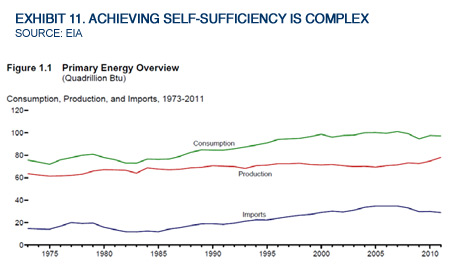Musings: Is America Knocking On The Door Of Energy Independence?
This opinion piece presents the opinions of the author.
It does not necessarily reflect the views of Rigzone.
A phrase introduced into the modern lexicon by President Richard Nixon in the early 1970s was "energy independence". Ever since then, as the nation's domestic oil production declined and our natural gas output stagnated resulting in ever-increasing imports of foreign oil and Canadian gas, national politicians campaigned on plans to make America energy independent. Nearly 40 years after President Nixon uttered the phrase, the shale revolution has transformed America's petroleum industry into an engine for hydrocarbon production growth. With that additional oil and gas production, America's dependence on petroleum imports has declined. Increasingly, not only are the politicians talking about energy independence, but energy industry executives along with energy economists and consultants are also openly talking about the day when the U.S. meets all its power needs from domestic resources.
In late September, the Energy Information Administration (EIA) released data showing weekly domestic crude oil production had reached the highest level since January 1997 – some 15 years ago. Reports are that despite the slowdown in drilling in the Bakken formation in North Dakota and Montana, production there should continue to rise during the second half of 2012. Two charts demonstrate the significance of the increase in domestic production. The first chart (Exhibit 8, next page) shows the weekly estimate of domestic crude oil production since January 1990 with a red line showing how the September 21 data compares with production in early January 1997.

The second chart (Exhibit 9) shows the weekly domestic production and the weekly oil import figures. That latter weekly data series is susceptible to considerable fluctuation due to market conditions and weather impacts on tanker operations. What is obvious from this chart is the peak in oil imports and subsequent decline coinciding with the bottoming of weekly oil production and its subsequent increase.

The decline in oil imports appears to be significant, but part of the explanation is that overall oil demand has dropped. That is shown by the chart in Exhibit 10. The chart shows total petroleum consumption and the weekly demand for gasoline. Gasoline demand shows slowing growth in 2007-2008 and then the beginning of a decline associated with the recession and changes in vehicle miles driven. The overall decline in petroleum consumption is largely explained by this decline in gasoline consumption. Due to this relationship, we know that to understand the future of the oil market in the United States, one must watch gasoline consumption and domestic oil production. Any change to their recent trend – either up or down – will impact the nation's goal of achieving energy independence.

The EIA's recent data showed that America has achieved 83 percent energy self-sufficiency. Again, the explanation for this high level is due to the combination of flat consumption, rising domestic production (oil, gas, coal and renewables) and declining imports of oil and LNG. Optimists expect domestic energy production to continue to grow, but that assumption depends on governmental energy policies and the nation's energy consumption, which in turn depends on the economy's growth.

Yes, the nation is knocking on the door of energy independence, but some of the recent gains are the result of weak energy demand. Reaching a higher level of national energy self-sufficiency may actually signal that we are more a hostage to a weak economy with potentially significant social ills rather than having unlocked our true domestic energy potential. Reaching energy independence will likely remain an elusive goal for many years.
WHAT DO YOU THINK?
Generated by readers, the comments included herein do not reflect the views and opinions of Rigzone. All comments are subject to editorial review. Off-topic, inappropriate or insulting comments will be removed.
Managing Director, PPHB LP
- What's Next for Oil? Analysts Weigh In After Iran's Attack
- Venezuela Authorities Arrest Two Senior Energy Officials
- CNOOC Bags Contract for 4.6 MMcf of LNG for Philippines
- EIA Raises WTI Oil Price Forecasts
- EU Gas Storage Nearly 60 Percent Full at End of Heating Season
- ExxonMobil Makes FID on 6th Project in Contested Guyana Asset
- Is The Iran Nuclear Deal Revival Project Dead?
- ORE Catapult Looks for New CEO as Jamieson Steps Down
- Japan's Mizuho Invests $3.64MM in Bison's CCS Project in Alberta
- Equinor Advances First Battery Storage Projects in USA
- Macquarie Strategists Warn of Large Oil Price Correction
- JPMorgan CEO Says LNG Projects Delayed Mainly for Political Reasons
- USA, Venezuela Secretly Meet in Mexico as Oil Sanctions Deadline Nears
- EIA Ups Brent Oil Price Forecast for 2024 and 2025
- Petrobras Discovers Oil in Potiguar Basin
- EIR Says Oil Demand Will Not Peak Before 2030
- Biden Plans Sweeping Effort to Block Arctic Oil Drilling
- Pantheon Upgrades Kodiak Estimates to 1.2 Billion Barrels
- Dryad Flags Red Sea 'Electronic Warfare' Alert
- Russian Oil Is Once Again Trading Far Above the G-7 Price Cap Everywhere
- Oil and Gas Executives Predict WTI Oil Price
- New China Climate Chief Says Fossil Fuels Must Keep a Role
- Chinese Mega Company Makes Another Major Oilfield Discovery
- Oil and Gas Execs Reveal Where They See Henry Hub Price Heading
- Equinor Makes Discovery in North Sea
- ExxonMobil Racks Up Discoveries in Guyana Block Eyed by Chevron
- Macquarie Strategists Warn of Large Oil Price Correction
- DOI Announces Proposal for Second GOM Offshore Wind Auction
- Standard Chartered Reiterates $94 Brent Call
- Chevron, Hess Confident Embattled Merger Will Close Mid-2024


